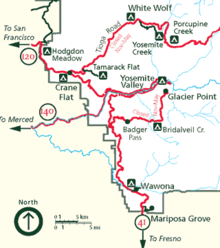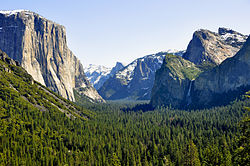- Mariposa Grove
-
Mariposa Grove is a sequoia grove located near Wawona, California, United States, in the southernmost part of Yosemite National Park. It is the largest grove of Giant Sequoias in the park, with several hundred mature examples of the tree. Two of its trees are among the 25 largest Giant Sequoias in the world.
The Mariposa Grove was first visited by non-natives in 1857 when Galen Clark and Milton Mann found it. They named the grove after Mariposa County, California, where the grove is located.[1]
The Giant Sequoia named Grizzly Giant is between probably 1900–2400 years old: the oldest tree in the grove.[2] In 1932, park officials claimed it as the fifth largest (by volume) tree in the world, but other trees were subsequently found to be larger. It has a volume of 34,010 cubic feet (963 m3), and is counted as the 25th largest tree in the world. It is 210 feet (64 m) tall, and has a heavily buttressed base with a basal circumference of 28 m (92 ft) or a diameter of 30 feet (9.1 m); above the buttresses at 2.4 m above ground, the circumference is only 23 m. Grizzly Giant's first branch from the base is 2 m (6 ft) in diameter. Another tree, the Wawona Tree, had a tunnel cut through it in the nineteenth century that was wide enough for horse-drawn carriages and early automobiles to drive through. Weakened by the large opening at its base, the tree fell down in a storm in 1969.
Abraham Lincoln signed an Act of Congress on June 30, 1864 ceding Mariposa Grove and Yosemite Valley to the state of California. Criticism of stewardship over the land led to the state's returning the grove to federal control with the establishment of Yosemite National Park.
The Mariposa Grove Museum is listed on the National Register of Historic Places.
Contents
Noteworthy trees
Some of the trees found in the grove that are worthy of special note are:
- The Fallen Monarch: A tree that fell more than three hundred years ago. Giant sequoias are resistant to decay, so their remains can linger for a long period of time if undisturbed.
- The Bachelor and Three Graces: A group of four trees, three of them growing very close together, with a fourth a little more distant. Their roots are so intertwined that if one of them were to fall, it would likely bring the others along with it.
- The Grizzly Giant: The oldest tree and second largest tree in the grove, with a volume of 34,010 cubic feet (963 m3)
- The Washington tree: the largest tree in the grove, with a volume of 35,950 cubic feet (1,018 m3)
- The California Tunnel tree: Cut in 1895 to allow coaches to pass through it (and as a marketing scheme to attract visitors to the grove), this is the only living tree with a tunnel in it since the fall of the Wawona Tunnel Tree in 1969.
- The Faithful Couple: A rare case in which two trees grew so close together that their trunks have fused together at the base.
- The Clothespin tree: Countless fires throughout the decades nearly severed this tree's trunk, creating a space in it large enough for a pick-up truck to drive through.
- The Telescope tree: A tree that has become completely hollow from repeated fires through the decades. Despite that, the tree is still living, as Giant Sequoias do not require a whole trunk to survive. It is possible to walk inside the tree and, from there, see the sky. This condition leaves the tree weakened and makes it more difficult for it to withstand strong winds. This tree (and the Clothespin Tree) could topple at any time.
- The Columbia tree: The tallest tree in the grove and in Yosemite National Park at 285 feet (87 m).
- The Galen Clark tree: Of historical importance, as it is said to be the first tree seen by Galen Clark when he entered the grove, and inspired his love for the Giant Sequoias and struggle for setting aside the land for preservation, a new concept in the mid-19th century.
- The Wawona Tunnel Tree: Renamed the "Fallen Tunnel Tree" after it toppled over during a snow storm in 1969. In 1881, this was the first tree to have a tunnel carved through its trunk. Its collapse is seen as a turning point in the preservation program in National Parks in the United States. So grave was the shock of the tree's collapse that the result was a greater awareness of the sensitivity of ecosystems, even for a living thing as massive as the Giant Sequoias.
- The Fallen Giant: It was one of the largest trees in the grove, until it fell in 1873.
- The Massachusetts tree: It was one of the most famous trees in the grove. It fell in 1927.
See also
- List of largest giant sequoias
- List of trees
References
- ^ Farquhar, Francis P. (1926). Place Names of the High Sierra. San Francisco: Sierra Club. http://www.yosemite.ca.us/history/place_names_of_the_high_sierra/m.html.
- ^ Stephenson, Nathan L. (2002-01). "Estimated Ages of Some Large Giant Sequoias: General Sherman Keeps Getting Younger". Sierra Nature Notes 2. Archived from the original on 2007-11-17. http://web.archive.org/web/20071117060621/http://www.yosemite.org/naturenotes/sequoiaresults.htm.
Further reading
- Geology of U.S. Parklands: Fifth Edition, Eugene P. Kiver and David V. Harris (John Wiley & Sons; New York; 1999; page 227) ISBN 0-471-33218-6
External links
- Mariposa Grove of Giant Sequoias - Yosemite National Park
- Yosemite and the Mariposa Grove: A Preliminary Report, 1865, California State
- "Mariposa Grove", National Geographic Society[dead link]
- Record from the 38th Congress, 1864 Act granting the grove to California
- Record from the 59th Congress, Act returning the grove to federal control
- Short radio episode Samoset about John Muir showing Ralph Waldo Emerson the Mariposa Grove, from The Life and Letters of John Muir, 1923. California Legacy Project.
National Register of Historic Places in Yosemite National Park National Historic Landmarks Other historic districts Bagby Stationhouse, Water Tanks and Turntable | Camp Curry Historic District | Great Sierra Mine Historic Site | Yosemite Valley | Yosemite Valley Archeological District | Yosemite Valley Bridges | Yosemite Village Historic District
Other properties Acting Superintendent's Headquarters | Camp 4 | Crane Flat Fire Lookout | Glacier Point Trailside Museum | Great Sierra Wagon Road | Hetch Hetchy Railroad Engine No.6 | Hodgdon Homestead Cabin | Chris Jorgenson Studio | Mariposa Grove Museum | McCauley Cabin | McCauley and Meyer Barns | McGurk Cabin | Merced Grove Ranger Station | Soda Springs Cabin | Tioga Pass Entrance Station | Track Bus No. 19 | Tuolumne Meadows | Tuolumne Meadows Ranger Stations and Comfort Stations | Wawona Covered Bridge | Yosemite Transportation Company Office | Yosemite Valley Chapel | Yosemite Valley Railroad Caboose No. 15
See also: National Register of Historic Places in Yosemite National Park U.S. National Register of Historic Places Topics Lists by states Alabama • Alaska • Arizona • Arkansas • California • Colorado • Connecticut • Delaware • Florida • Georgia • Hawaii • Idaho • Illinois • Indiana • Iowa • Kansas • Kentucky • Louisiana • Maine • Maryland • Massachusetts • Michigan • Minnesota • Mississippi • Missouri • Montana • Nebraska • Nevada • New Hampshire • New Jersey • New Mexico • New York • North Carolina • North Dakota • Ohio • Oklahoma • Oregon • Pennsylvania • Rhode Island • South Carolina • South Dakota • Tennessee • Texas • Utah • Vermont • Virginia • Washington • West Virginia • Wisconsin • WyomingLists by territories Lists by associated states Other  Category:National Register of Historic Places •
Category:National Register of Historic Places •  Portal:National Register of Historic PlacesCategories:
Portal:National Register of Historic PlacesCategories:- Giant sequoia groves
- Forests of California
- Yosemite National Park
- Protected areas of Mariposa County, California
Wikimedia Foundation. 2010.





